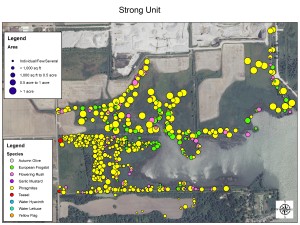October 27, 2015
Nicole LaFleur, Greg Norwood, and Jake Bonello (USFWS)

Figure 1: After non-native Phragmites removal. Prior to management, the wetland was dominated by dense, mono-typic non-native Phragmites. Photo: Greg Norwood
Non- native Phragmites is not a new concern in the Detroit River and Western Lake Erie Cooperative Weed Management Area (CWMA): managers have been treating Phragmites and restoring habitats within the Detroit River International Wildlife Refuge for years. We have seen truly incredible transformations from acres of mono-typic stands of non-native Phragmites to functional coastal wetlands full of native plants, resembling historical communities (Figure 1). Combinations of herbicide spraying, mowing, and prescribed burns have been successful. However, there is still a lot to do. Thanks to a two year grant from the Michigan Invasive Species Grant Program, and cooperative management with The Nature Conservancy and Huron-Clinton Metropolitan Authority, a team of three biological technicians was hired in May of 2015 to focus on invasive species control.
As the end of our first field season approaches, we reflect on the impacts that have been made this summer and consider the next steps in maintaining a successful management program. Our field season was split up into two parts: data collection/mapping and treatment. We used GPS devices to plot stands of non-native Phragmites (and other invasive plants such as European frog-bit, flowering rush, yellow flag iris, autumn olive, and garlic mustard). Area, density, probability of expansion, site quality, and whether or not the area had been previously treated were all recorded. The products of this information are detailed maps, plotted with populations of non-native Phragmites and their characteristics (Figures 2 and 3). As the project continues, these maps will allow us to track changes through the years. In addition to the valuable maps, our data collection period also allowed us to prioritize populations to be treated based on site quality and probability of expansion.

Figure 3: 2015 map of invasive plants. Non-native Phragmites is still very abundant, but the wetland is full of diverse native species as well (not shown).
By August, our mapping was completed and it was time to start herbicide treatments. We used a variety of methods this year, including broadcast spraying from a helicopter, and targeted spraying from a Marsh Master and backpacks, depending on population size.
While we are starting to see some yellowing, we do not have true results from our treatments yet, and herbicide application is just one of several steps in the process. Dead stands of non-native Phragmites don’t exactly promote seed bank growth, so fire and mowing during winter months might be necessary. Next year will follow the same pattern: we will re-map and compare, and then continue treatments. Even once our goals are met, early detection and rapid response will be crucial to maintain healthy, functional wetlands that meet the mission of the Detroit River International Wildlife Refuge.

